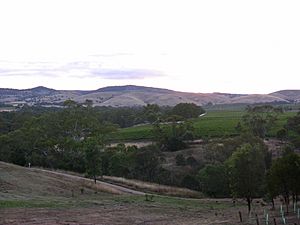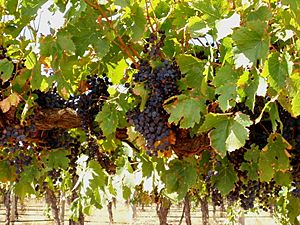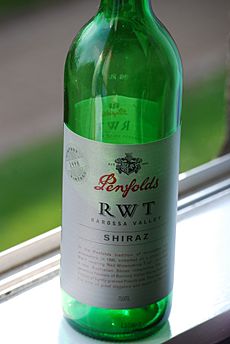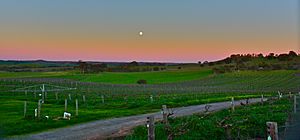Barossa Valley (wine) facts for kids
| Wine region | |
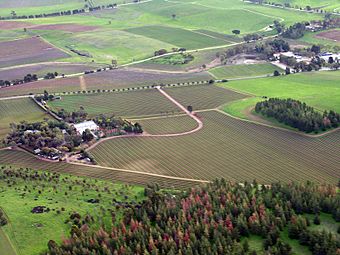
Aerial view of the Barossa Valley
|
|
| Type | Geographical indication (GI) |
|---|---|
| Year established | 1997 |
| Years of wine industry | Since 1843 |
| Country | Australia |
| Part of | Barossa Zone |
| Growing season | October-April |
| Climate region | Mediterranean |
| Heat units | 1710 |
| Soil conditions | Clay loam through to sandy |
| Size of planted vineyards | 10,350 hectares (25,600 acres) |
| Varietals produced | |
| No. of wineries | 37 |
| Comments | Data from 2012 |
The Barossa Valley is one of Australia's oldest and most important wine regions. It is located in South Australia, about 56 kilometers (35 miles) northeast of Adelaide. Unlike many other Australian wine areas, the Barossa Valley was started by German settlers. They came here to escape problems in their homeland.
The Barossa Valley has a warm climate. This climate helps grow very ripe grapes. These grapes were first used to make strong, sweet wines called fortified wines. Later, the focus shifted to red table wines. For a while, the Barossa Valley was not as popular because its main grape, Shiraz, was often used for blending.
However, in the 1980s, some smaller wineries started making special wines from old Shiraz vines. These wines became famous around the world. They were known for being full-bodied red wines with rich flavors like chocolate and spice. This made the Barossa Valley a top wine region in Australia again. Many large and well-known wineries, like Penfolds and Yalumba, are based here. Some Shiraz vines are very old, even 100-150 years old! Other grapes grown here include Grenache, Mourvedre, Cabernet Sauvignon, Riesling, Chardonnay, and Semillon.
In 2011, a special law was made to protect the Barossa Valley. This law helps keep its unique history and wine culture safe. It stops the area from becoming just another suburb of Adelaide.
Contents
History of Barossa Valley Wine
The Barossa Valley was first explored in 1837. It was surveyed in 1839 by William Jacob. The name "Barossa" comes from a battle in Spain called the Battle of Barrosa. Colonel William Light, who fought in that battle, named the area. There was a small mistake in spelling, so it became "Barossa."
Most of Australia's wine industry was influenced by British settlers. But the Barossa Valley was different. It was shaped by German families who came from Silesia (now part of Poland). In 1841, a company offered these families a safe journey and land in the Barossa Valley. About 500 families accepted and settled there.
At first, the settlers tried different types of farming. They soon found that the warm, fertile valley was perfect for growing grapes. In the early days, they learned about winemaking through trial and error. Their home country, Silesia, did not have much winemaking tradition.
Early Grapes and Wines
The first main grape grown in the Barossa Valley was Riesling. This is a German grape. However, the hot valley floor made the Riesling wines very strong and sometimes turn brown. Some of this wine was even made into brandy. This led to a time when strong, sweet wines, like port-style wines, became very popular. Red grapes like Shiraz and Grenache were also planted for these wines.
In the mid-20th century, Australian wine changed. People wanted more regular, non-fortified wines. The Barossa Valley was seen as less important compared to cooler regions. This was partly because Barossa was known for Shiraz, which was not as popular as Cabernet Sauvignon at the time. Many Barossa grapes were just used in mixed wines, and the name "Barossa Valley" rarely appeared on labels.
Barossa's Rise to Fame
By the late 1900s, the Barossa Valley's reputation began to change. Smaller wineries started making excellent wines. Barossa Shiraz, in particular, became famous worldwide. It was known for its unique style: a big, full-bodied wine with rich flavors of chocolate and spice. This style became a symbol of Australian wine. A famous wine expert, Jancis Robinson, even called the Barossa Valley "Australia's most typical wine region."
Climate and Geography
The Barossa Valley generally has a continental climate. This means it has hot summers and cold winters. However, it also has many small valleys and hills. These create different small climates, called mesoclimates. Temperatures can be very warm on the valley floors. They get cooler as you go higher up the hills.
Even though it's known as a "warm climate region," some of its climate numbers are similar to cooler areas. The region gets about 1710 heating degree days during the growing season (October to April). The average temperature in January, when grapes ripen, is around 21.4 °C (70 °F). There is not much rain during the growing season, so vineyards often need extra water. However, some very old vineyards on the cooler western side of the valley do not use extra water.
Growing Grapes and Making Wine
Most vineyards in the Barossa Valley use irrigation because there isn't much rain during the growing season. But there are strict rules about how much water can be used. Some of the oldest vineyards, especially on the cooler western side, use dryland farming. This means they don't use irrigation. This method, along with the naturally lower yields of old vines, helps produce very flavorful grapes. These grapes are often used for the most expensive Barossa Valley wines.
Grapes are usually picked in February. Sometimes, they are picked at night when it's cooler. This helps keep the acid levels in the grapes balanced.
The hot climate often means grapes get very ripe. This leads to high sugar levels and low acid levels. Winemakers often add acid to the wine to make it taste balanced. High alcohol levels can be managed by different methods, like reverse osmosis or adding water to the grape juice.
Historically, winemakers in Barossa used short maceration times. This means the grape juice did not stay in contact with the skins for very long. This often made the wines feel smooth in the mouth. Barossa Valley winemaking also uses a lot of oak barrels. American oak barrels are often used more than French oak. American oak can give wines flavors like dill and coconut.
Grapes and Wines of Barossa Valley
The Barossa Valley is most famous for its Shiraz grapes. But it also grows many other types. These include Riesling, Semillon, Chardonnay, Grenache, Mourvedre, and Cabernet Sauvignon. The popularity of Shiraz has also led to more interest in other grapes from the Rhone region, like Grenache and Mourvedre (also called Mataro in Australia). Many of these vines are very old, from the time when fortified wines were popular.
Even though it's known for red wines, the Barossa Valley also makes a lot of white wine. Riesling used to be very important here. Now, many Rieslings labeled "Barossa" might include grapes from the cooler Eden Valley wine region. This is allowed because the geographical indication of the Barossa Zone includes both the Barossa Valley and the Eden Valley. Eden Valley is known for its high-quality Riesling.
The Semillon grapes in the Barossa Valley have developed a special type, or clone, that has pink skin. This is different from Semillon found in Bordeaux, France, or the Hunter Valley in New South Wales. Barossa Semillon wines are usually full-bodied, golden in color, and have low acidity. They used to be fermented in oak barrels, but now they are often made in stainless steel. Barossa Chardonnay wines are often aged in oak and go through a process called malolactic fermentation. This makes them big, full-bodied, and creamy.
Other pages



